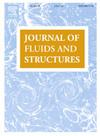Numerical study on three-dimensional self-induced inverted flag
IF 3.4
2区 工程技术
Q1 ENGINEERING, MECHANICAL
引用次数: 0
Abstract
The current study aims to investigate the fluid–structure interaction (FSI) of flexible thin structures undergoing large displacements using numerical simulations. The primary case of interest is the self-induced inverted flag problem, which exhibits a rich set of coupled fluid–structure behavior and flapping dynamics. To achieve this, a new FSI algorithm is proposed via a partitioned approach. The proposed algorithm uses the remeshed-Vortex Particle Method (VPM) to resolve the flow and a finite element method-based elastodynamics solver to evaluate the response of the flexible structure. The remeshed-VPM algorithm is modified and extended in this study with new developments to enhance its applicability for complex FSI simulations of thin flexible structures. A multiresolution scheme is developed and applied in combination with the iterative Brinkman penalization method for remeshed-VPM. A new force formulation is introduced that is based on corrected penalization velocity, which can generate distributed body forces for the iterative Brinkman penalization method. Finally, the fully 3D remeshed-VPM is applied in conjunction with corotational beam formulation for FSI simulations of the inverted flag system. The FSI solver is utilized to conduct a series of simulations on the 2D and 3D inverted flag model, aiming to gain insights into the intricate dynamics of these fluid–structure interactions.
三维自诱导倒旗的数值研究
目前的研究旨在通过数值模拟来研究承受大位移的柔性薄结构的流固耦合(FSI)问题。主要研究对象是自诱导倒旗问题,该问题表现出丰富的流固耦合行为和拍击动力学。为此,我们通过分区方法提出了一种新的 FSI 算法。所提出的算法使用重置涡粒法(VPM)来解决流动问题,并使用基于有限元法的弹性动力学求解器来评估柔性结构的响应。本研究对重置涡粒子法进行了新的修改和扩展,以提高其在薄柔性结构的复杂 FSI 模拟中的适用性。我们开发了一种多分辨率方案,并将其与布林克曼迭代惩罚法结合应用于重置-VPM。此外,还引入了一种基于校正惩罚速度的新受力公式,可为迭代布林克曼惩罚法生成分布式体力。最后,将全三维重置-VPM 与惯性梁公式相结合,用于倒旗系统的 FSI 仿真。利用 FSI 求解器对二维和三维倒旗模型进行了一系列模拟,旨在深入了解这些流体与结构相互作用的复杂动力学。
本文章由计算机程序翻译,如有差异,请以英文原文为准。
求助全文
约1分钟内获得全文
求助全文
来源期刊

Journal of Fluids and Structures
工程技术-工程:机械
CiteScore
6.90
自引率
8.30%
发文量
173
审稿时长
65 days
期刊介绍:
The Journal of Fluids and Structures serves as a focal point and a forum for the exchange of ideas, for the many kinds of specialists and practitioners concerned with fluid–structure interactions and the dynamics of systems related thereto, in any field. One of its aims is to foster the cross–fertilization of ideas, methods and techniques in the various disciplines involved.
The journal publishes papers that present original and significant contributions on all aspects of the mechanical interactions between fluids and solids, regardless of scale.
 求助内容:
求助内容: 应助结果提醒方式:
应助结果提醒方式:


